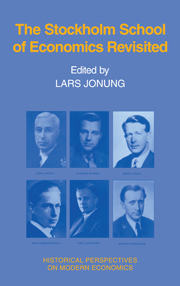Book contents
- Frontmatter
- Dedication
- Contents
- Preface
- List of Contributors
- Dramatis Personae at the end of 1937
- Introduction and Summary
- Part I The roots
- 1 The Political Economy Club and the Stockholm School, 1917–1951
- 2 Gösta Bagge, the Rockefeller Foundation, and empirical social science research in Sweden, 1924–1940
- Comment
- Comment
- 3 The Committee on Unemployment and the Stockholm School
- Part II The approach of the Stockholm School
- Part III The impact of the Stockholm School
- Part IV What remains of the Stockholm School?
- The Stockholm School: A non-Swedish bibliography
Comment
Published online by Cambridge University Press: 05 July 2013
- Frontmatter
- Dedication
- Contents
- Preface
- List of Contributors
- Dramatis Personae at the end of 1937
- Introduction and Summary
- Part I The roots
- 1 The Political Economy Club and the Stockholm School, 1917–1951
- 2 Gösta Bagge, the Rockefeller Foundation, and empirical social science research in Sweden, 1924–1940
- Comment
- Comment
- 3 The Committee on Unemployment and the Stockholm School
- Part II The approach of the Stockholm School
- Part III The impact of the Stockholm School
- Part IV What remains of the Stockholm School?
- The Stockholm School: A non-Swedish bibliography
Summary
The main thrust of this conference is directed toward the theoretical and methodological achievements of the Stockholm School of Economics. But we must not forget that most of its members were well versed in empirical, fact-finding economics. And several of them took a very active part in shaping actual economic policy.
Earlene Craver has thrown light on the crucial rôle Gösta Bagge played in initiating and finding finance for the long-term “Stockholm Economic Studies.” Here Gunnar Myrdal studied the development of the cost of living in Sweden 1830–1930. Gösta Bagge, Erik Lundberg, and Ingvar Svennilson investigated wages from 1860 to 1930. Erik Lindahl, Einar Dahlgren, and Karin Kock prepared two massive volumes about the national income in Sweden 1861–1930.
One of the off-shoots of the Unemployment Committee was the Konjunkturinstitut (The Swedish Economic Research Institute). Dag Hammarskjöld, Undersecretary of the Treasury in 1936, was instrumental in realizing the project. And Erik Lundberg was head of the Institute until 1955.
Another important feature of the life and work of the Stockholm School economists was their heavy involvement in politics and the day-to-day running of economic policy. Bagge became leader of the Conservative Party and was a member of the coalition Cabinet during the war years. Bertil Ohlin became leader of the Liberal Party and served – like Myrdal – for a period, albeit short, as Minister of Trade.
- Type
- Chapter
- Information
- The Stockholm School of Economics Revisited , pp. 100 - 102Publisher: Cambridge University PressPrint publication year: 1991

